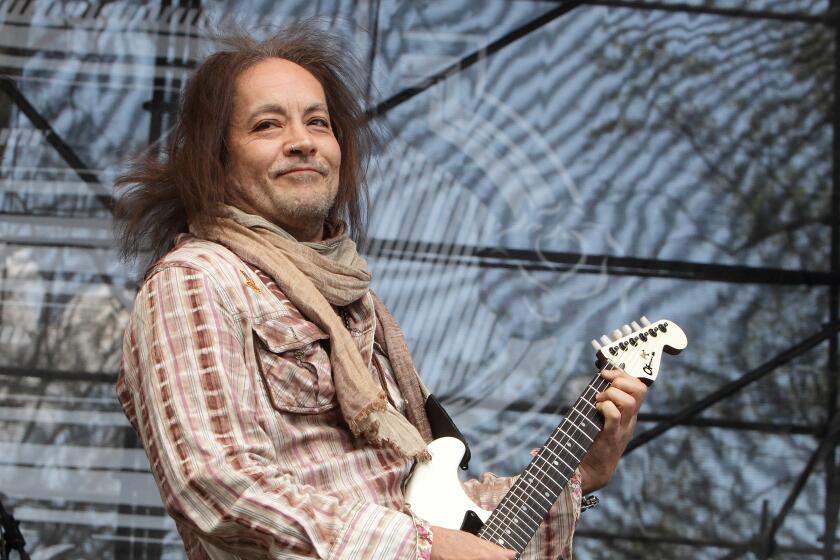A higher state for ‘Tristan’
“The Tristan Project” is back.
The unforgettable infernos and floods of Bill Viola’s videos have returned to Walt Disney Concert Hall. Spirits once more leave bodies. Passion and desire again slowly well up from a single, ambiguous harmony -- played as if magically disembodied sound by the Los Angeles Philharmonic -- and gradually culminate in one of art’s most persuasive acts of transformation.
For a second time, Frank Gehry’s concert hall interior, designed like a ship, becomes an actual vessel for a spiritual journey. Here Tristan and Isolde, those lovers in Wagner’s opera with their famous gaze, embody as never before the composer’s pan-Christian Buddhist (or is that pan-Buddhist Christian?) vision of a higher, ineffable, infinity-drunk starry state.
This is not, as director Peter Sellars put it, puppy love.
And Esa-Pekka Salonen has not yet left the room.
The Philharmonic is news rich. The announcement last week that Salonen would step down as music director in 2009, to be succeeded by Gustavo Dudamel, has attracted extraordinary interest. India and China reported it. “Tonight Show” representatives keep showing up at Disney hoping to snag the curly-haired young Venezuelan conductor, even though he’s back in Caracas. Al Jazeera wants an interview.
But “The Tristan Project” redux -- which was given an act at a time Thursday, Friday and Saturday nights and which will be presented complete this week and next in Disney -- goes way beyond the news and places it in a profound context. The Buddhist bits of Wagner’s opera concern the notion of non-attachment. Everything must end. The only moment that means anything is this one.
So let’s drop Dudamel for now. His time will come. What matters is that “The Tristan Project” is, quite simply, the great Los Angeles artwork of our time. And like Tristan and Isolde’s transcendent love, which could find redemption only in death, the project’s time with us is short.
This collaboration by Salonen, Sellars and Viola -- L.A.’s most internationally celebrated musician, director and visual artist -- was first presented at Disney two years ago. Each act of Wagner’s opera, semi-staged by Sellars, backed up by Viola’s searing large-screen video imagery and Salonen’s incendiary conducting, presented a radical reimagining of Wagner, once known as the composer of the future, for the future.
“Tristan” was given then, as it was last week, over three days, an act at a time. The concerts began, respectively, with works by Berg, Debussy and the contemporary Finnish composer Kaija Saariaho. Next, it was taken to Paris, where it was fully staged and where it proved a sensation, though a controversial one. In May, “The Tristan Project” will travel to New York, where the complete opera will be given in Avery Fisher Hall.
For last week’s revival, Salonen and Sellars made refinements. This time, Salonen preceded each act with a work by Debussy -- “Printemps” on Thursday, “Trois Nocturnes” before the nocturnal second-act love duet Friday and the Wagner-infused, pre-Raphaelite-lighted “La Damoiselle Elue” on Saturday. The cast was, with one important exception, mostly new. Although the work is still only partly staged, Sellars has incorporated elements of the Paris production.
But the biggest changes have been in the greater sense of depth and dimensionality. Music and drama have a tighter focus and added warmth. Viola’s imagery is personal, with ceremonies of purification, flames and forests and Tristan’s literally out-of-this-world final ascent from the ocean’s depth to the heavens. Four planes of sensation -- staging, singing, orchestra and screen -- must each have their own space.
The first time, Christine Brewer was still an unformed Isolde. She sang wonderfully but did not yet embody the role. Now she does in her total outpouring of gorgeous, confidently overpowering sound. In two short years, she’s become the Isolde of our time.
Salonen’s growth in the opera is more subtle but no less significant. Initially, he was finding his way through the score, presenting amazing instrumental details and thrilling propulsion. Now, he is inside the music. His pacing is more organic. Past the technical hurdles, he can give the score the same passion and sonic supremacy he does “Rite of Spring.”
The rest of the cast proved interesting. Alan Woodrow, a Canadian tenor, is a tyro Tristan. He has a clarion tone quality, but his voice is not in his command. If he tames it, he will be important.
Anne Sofie von Otter was a curious choice for Brangane. Dressed (like Brewer) in black velvet and looking like a glamorous Swedish actress in an Ingmar Bergman film, she helped demonstrate how significant Isolde’s maid can be to the drama. But though a radiant mezzo-soprano, she is no Wagnerian. Salonen helped her by keeping the orchestra down, but only in the third act did she finally seem vocally comfortable. As soloist in Debussy’s vocal work that night, she was captivating.
Sellars gives an unusual but convincing homoerotic subtext to the relationship between Tristan and King Mark, and John Relyea was the sonorous and moving King. Jukka Rasilainen (Kurwenal), Thomas Rolf Truhitte (Melot), Michael Slattery (Sailor and Shepherd) and Jinyoung Jang (Steersman) were all believable. The Los Angeles Master Chorale came through splendidly.
To attend “The Tristan Project” in Disney is to participate in an engulfing experience. If you need further enticement, check out the Philharmonic’s website, www.laphil.org. The orchestra promises that by the time you read this, it will have made available podcasts of Sellars and Viola in their impassioned and revelatory preconcert talks.
Then hie to Disney, where history is being made.
*
‘The Tristan Project’
Where: Walt Disney Concert Hall, 111 S. Grand Ave., L.A.
When: 6 p.m. Wednesday and April 24
Price: $39 to $150
Contact: (323) 850-2000 or www.laphil.org
More to Read
The biggest entertainment stories
Get our big stories about Hollywood, film, television, music, arts, culture and more right in your inbox as soon as they publish.
You may occasionally receive promotional content from the Los Angeles Times.











